How to Cook Halloumi Perfectly
An easy method for how to cook halloumi perfectly every time! For beautifully soft, squidgy, salty halloumi cheese that can be used in many different ways.
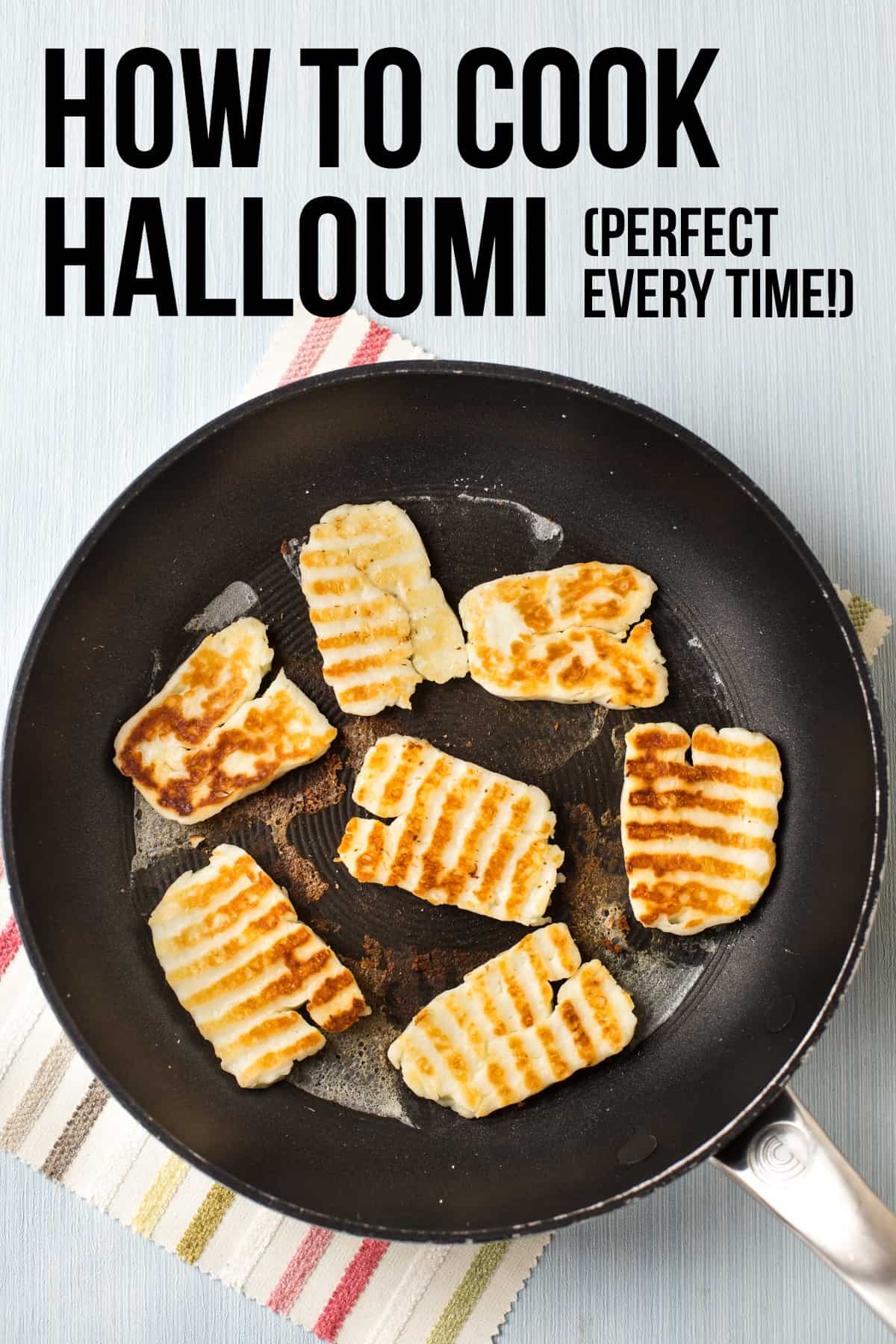
If you’re a regular reader here, you’ll probably already know how to cook halloumi – I share halloumi recipes here alllll the time. But if not, read on to find out everything you need to know!
I think halloumi might just be my favourite cheese ever – it truly is the king of cheeses. It’s soft, it’s salty, it’s gooey, it’s crispy, it’s squidgy… all at the same time. If you like the flavour of crispy cheese (and who doesn’t?!), you’ll love fried halloumi.
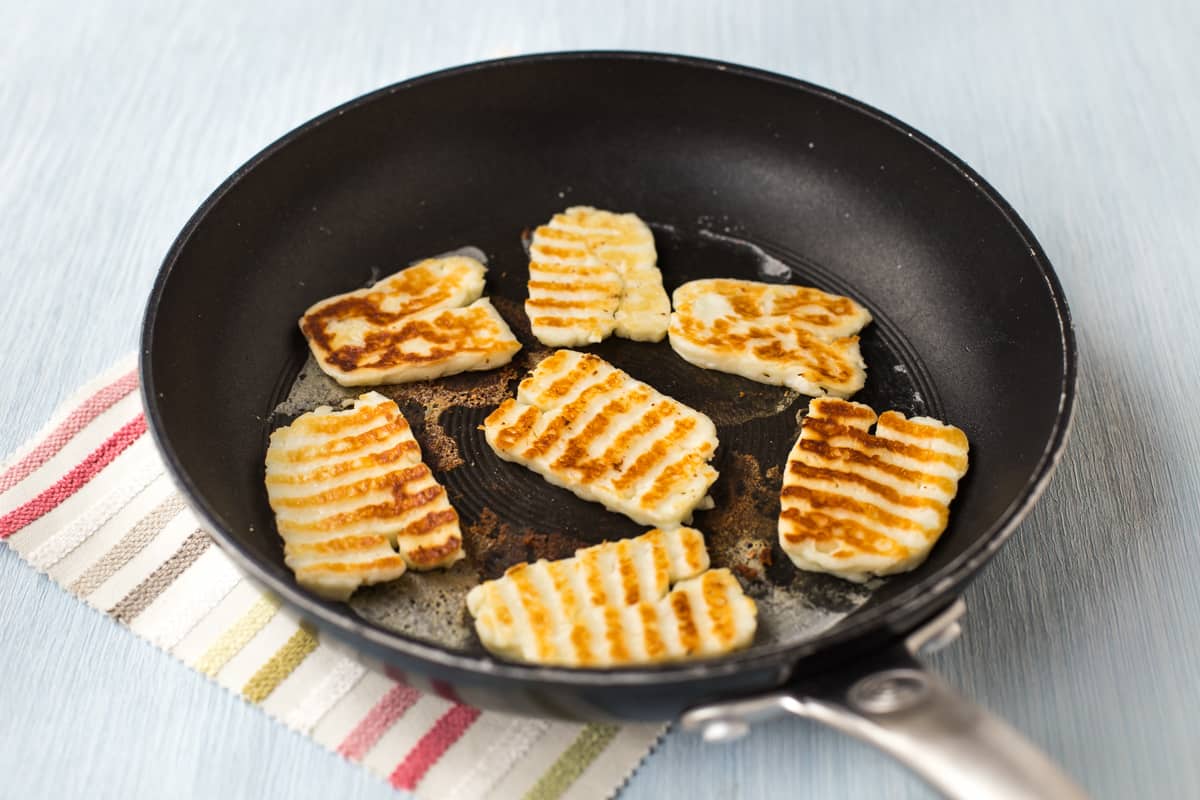
🛒 Where to buy halloumi cheese
In the UK, halloumi is easy to find in pretty much all supermarkets. It’s often rolled in dried herbs (usually mint) before being sold – which explains the little black dots you can see on the halloumi in some of my photos!
I know it can be a bit trickier to find halloumi in the shops in other countries. Since I have a lot of American readers, I asked in my Facebook group, Easy Vegetarian Dinners, where people had managed to find halloumi in the US, and people suggested Trader Joe’s, Whole Foods, and a few smaller stores – check out the full post here for more details (you’ll need to join the group first to view the post!).
You can even find it on Amazon! Here’s one I found that looks very similar to the stuff I use.
If you’re in any other country where halloumi is less common, I’d recommend either trying your nearest superstore, where they have the widest range of cheeses, or alternatively, try a smaller specialist store. It might be worth calling around first to see if anyone stocks it near you!
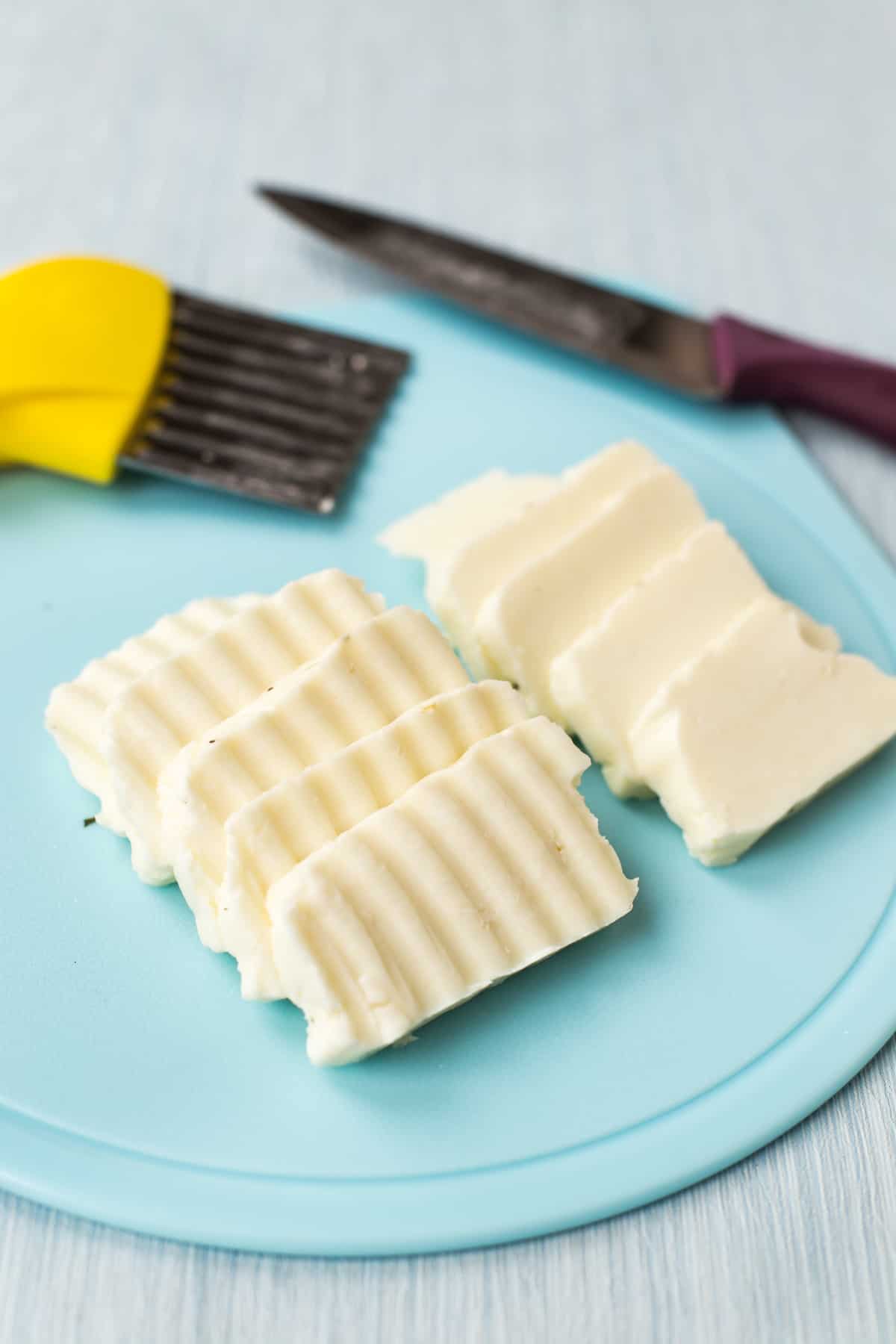
👩🏽🍳 How to cook halloumi
Here’s how to cook halloumi perfectly, every time!
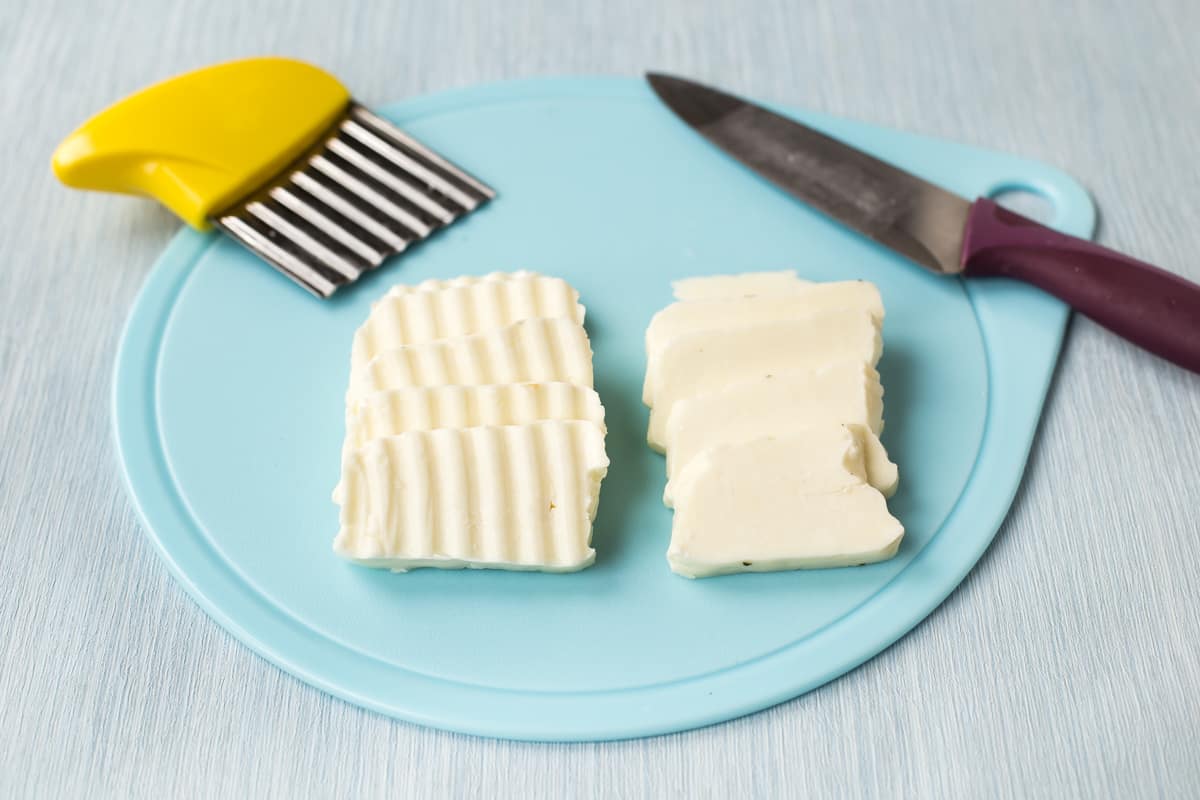
Step 1: Slice the halloumi.
I personally like to use fairly thick slices of halloumi – I find that if they’re too thin, they dry up and become a bit hard. Thick slices (anything from about half a centimetre, up to about a centimetre thick) go nice and gooey in the middle.
👌 Top tip
You can cook halloumi in a griddle pan, rather than a flat frying pan, to get perfect grill marks across the cheese. Or, if you don’t have a griddle pan, you can cheat by using a crinkle cutter to cut the cheese instead! It makes those beautiful golden stripes across the cheese, which are so eye-catching. Here are a couple of options on Amazon (UK / US).
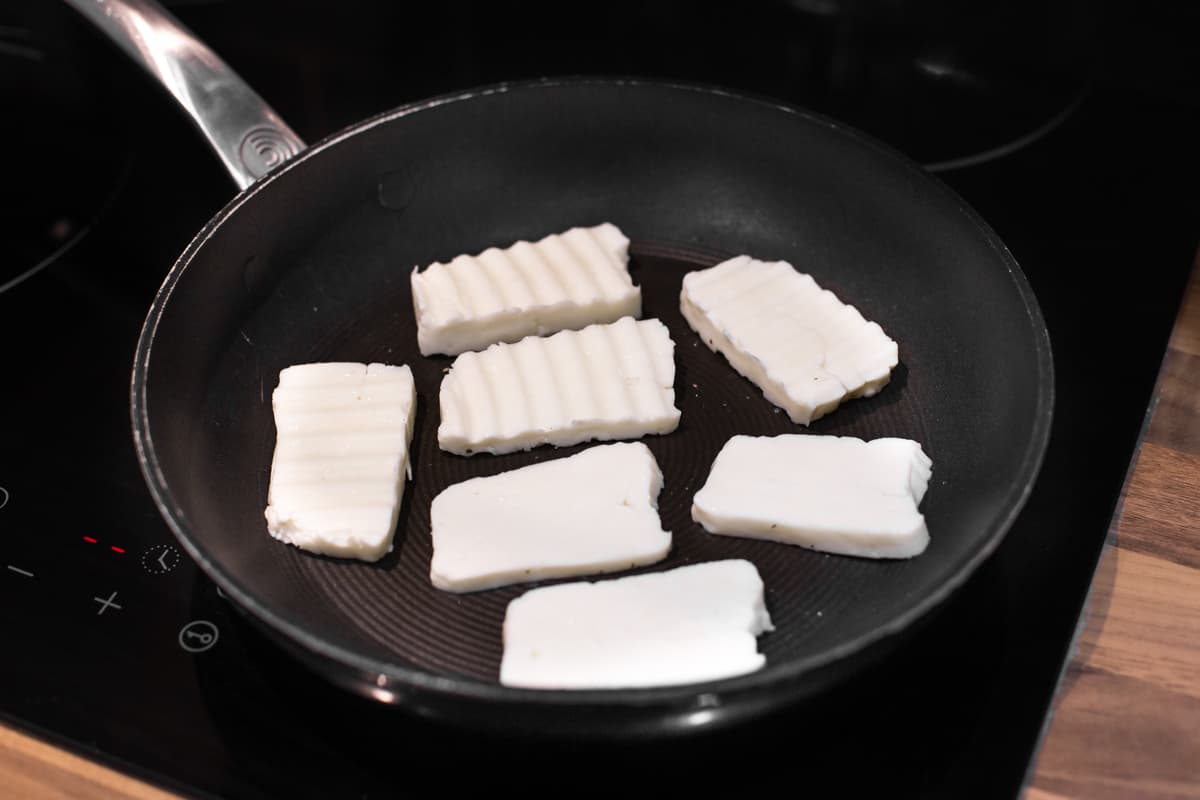
Step 2: Add the halloumi to a non-stick frying pan.
If you’re using a non-stick pan, you don’t need to add any oil. Since the halloumi releases some liquid as it cooks anyway, it doesn’t tend to stick – but it’s worth using a good quality non-stick pan anyway, just in case.
Turn the heat up to medium, and let it do its thing.
👌 Top tip
If you don’t have a non-stick frying pan, you can use stainless steel – but I would always go for the non-stick if you have one.
For the purposes of this post, I tried frying some halloumi in a stainless steel pan using a few different methods – oil vs. no oil; pre-heated pan vs. cold pan.
I found that you need to use a much lower heat when you’re cooking the halloumi in stainless steel, and a dash of oil was helpful to stop the cheese from sticking. But even so, the cheese did cook (and burn!) a lot more quickly in the stainless steel pan, so bear that in mind if you don’t have a non-stick pan.
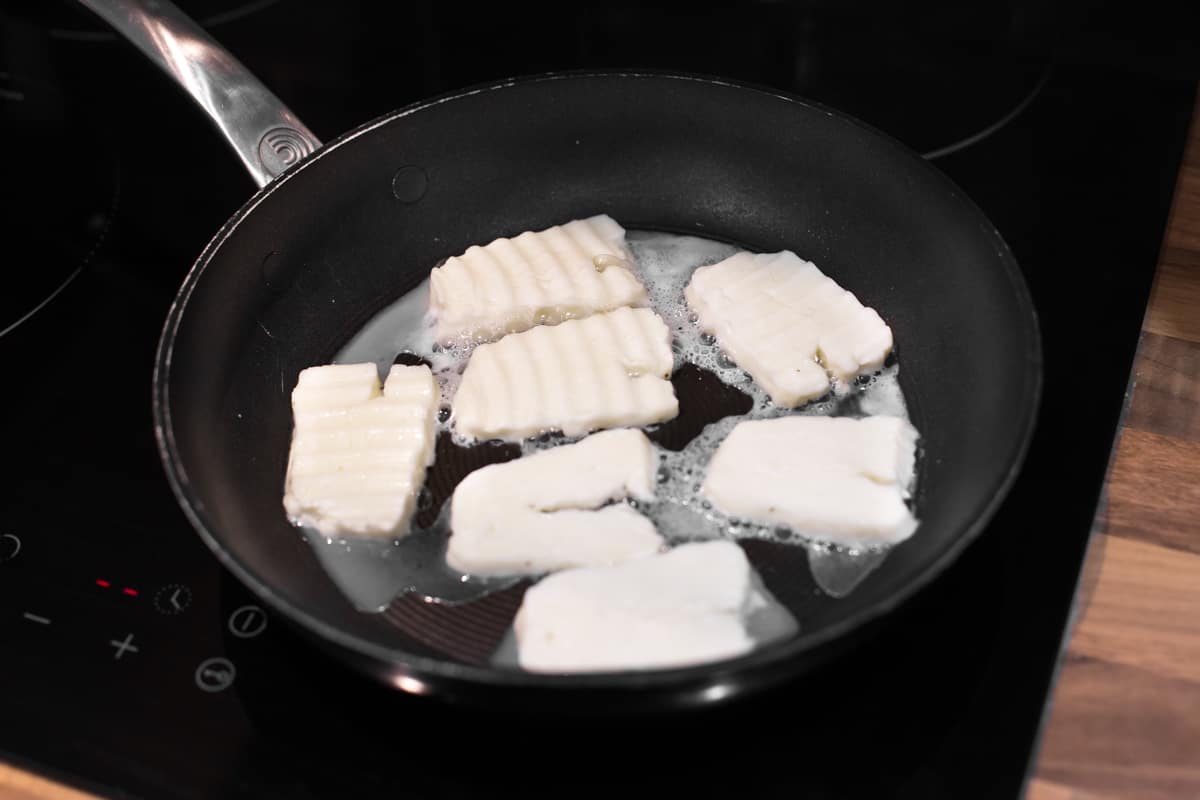
Step 3: Cook the first side of the halloumi.
After a minute or two, the halloumi will begin to release some liquid. Don’t flip the cheese just yet – wait until the liquid has all been released, and any excess liquid has evaporated.
As you can see, a salty substance will be left in the pan, which will turn golden brown when all the liquid has gone. The colour of the residue in the pan pretty much corresponds to the colour of the underside of the halloumi, so once it’s golden, it’s time to flip!
Notice that the cheese browns more quickly in the centre of the pan (at least it does on my stove!), so you might need to move the cheese around a little to help the edge pieces cook evenly.
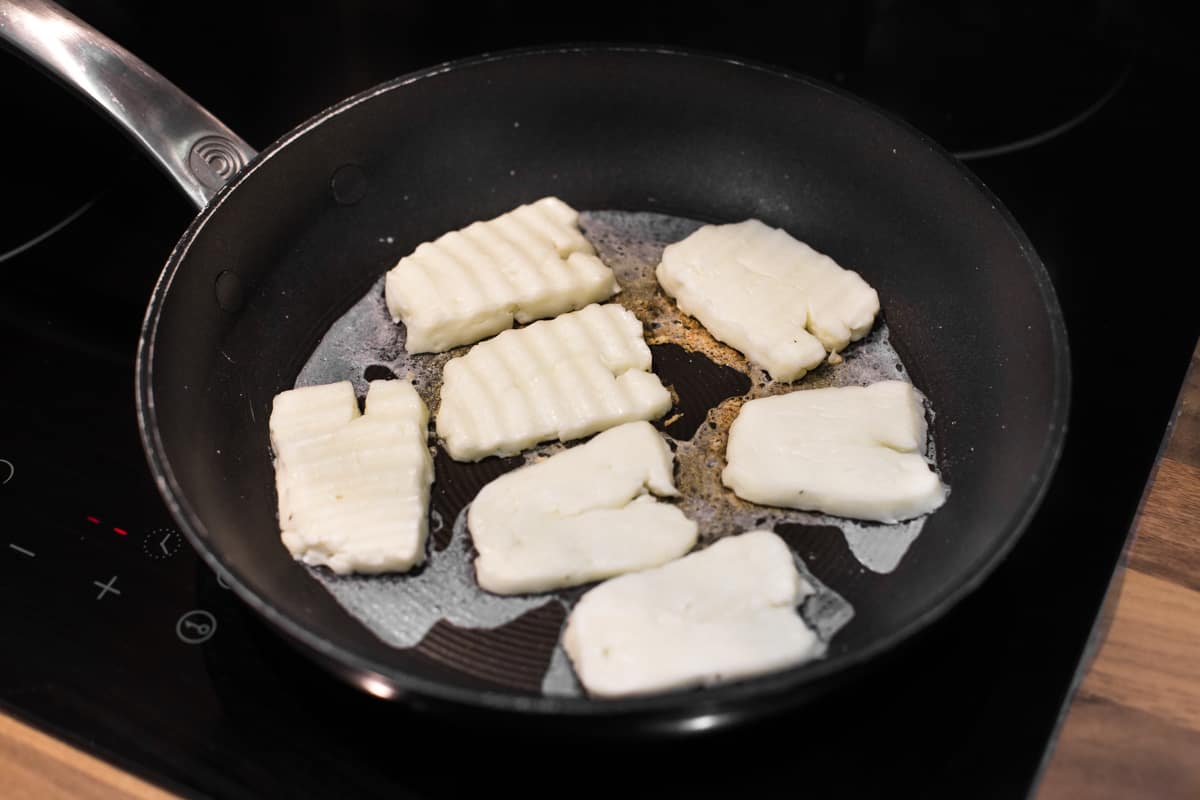
Step 4: Flip the halloumi.
When the underside of the halloumi is browned to your liking, flip each slice over, and repeat with the other side.
Beware: this side will brown a lot more quickly, as all the liquid has already been released – it should only take about a minute this time. Don’t overcook the halloumi, or it will end up becoming tough and rubbery.
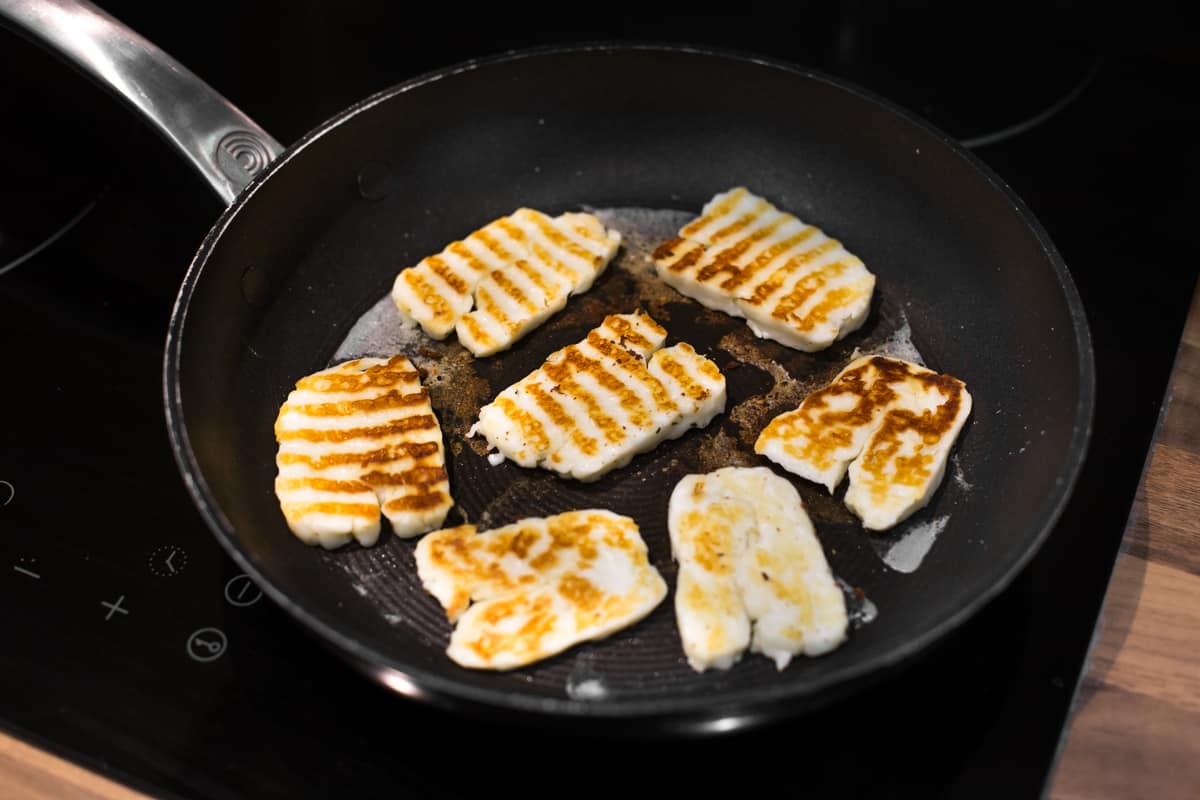
Step 5: Enjoy!
You should now have beautifully cooked halloumi, golden brown and crispy on the edges, soft and squidgy in the middle. Delicious!
Halloumi is best eaten straight away – just try to resist eating it straight from the pan, as that will probably be frowned upon by the rest of your family!
🧀 Halloumi FAQs
Halloumi (sometimes spelled haloumi) is a Cypriot cheese made from sheep’s, goat’s, and / or cow’s milks. It’s pretty unusual as far as cheese goes, because you can fry it up and it won’t melt away into oblivion like a lot of other cheeses would – it keeps its shape, and softens up just enough to become nice and squidgy in the middle.
The flavour of halloumi isn’t overly cheesy – it’s more just a super salty flavour, and nice and creamy. In terms of flavour, it’s a little like a saltier version of mozzarella. The texture is fairly firm, more like paneer.
You only need a small amount of halloumi to add a lot of flavour to your food – it’s got such an intense salty flavour that really lifts everything you cook to the next level!
Yes! You can definitely eat halloumi raw. However, you don’t often see uncooked halloumi served in a meal.
It’s definitely tastier when it’s been cooked, as it’s just irresistible when it’s warm and squidgy – not to mention, you get those lovely crispy bits around the edges. I always cook my halloumi if I’m using it in a meal.
But I’ll admit, I do often nibble a bit of raw halloumi straight from the block while I’m chopping it up, and it’s pretty tasty that way too.
Halloumi is understandably used a lot in Cypriot cuisine, as well as Greek, Turkish, etc. – it makes an incredible vegetarian doner kebab, for example.
But it’s also great to use in all sorts of other contexts – dice it up and put it in a halloumi pie, add it to a halloumi curry, or even crumble it into halloumi chilli. I pretty much use it in everything.
The method for cooking halloumi that I detail in this post is for those occasions when you’re cooking up the halloumi on its own, as opposed to cooking it in a sauce – like if you want to add it to a halloumi sandwich, scatter it on top of a halloumi salad, or serve it in your cooked breakfast!
Halloumi can become a little rubbery and tough if you don’t know how to use it. There are a few things you can do to avoid this:
– cut your slices of halloumi on the thicker side – very thin slices tend to become a little hard, rather than soft and squidgy, like thicker slices do.
– don’t overcook the halloumi – a couple of minutes on each side is all it needs! You still want it to be soft, not totally crispy.
– eat the halloumi within 5 minutes or so of cooking it – if you leave it to cool, it will become a little more rubbery.
Meh… not really. Technically, you could pop it in the microwave for a few seconds to try to revive it, but it does tend to become tougher and more rubbery this way. It’s undoubtedly best eaten within a few minutes of being cooked.
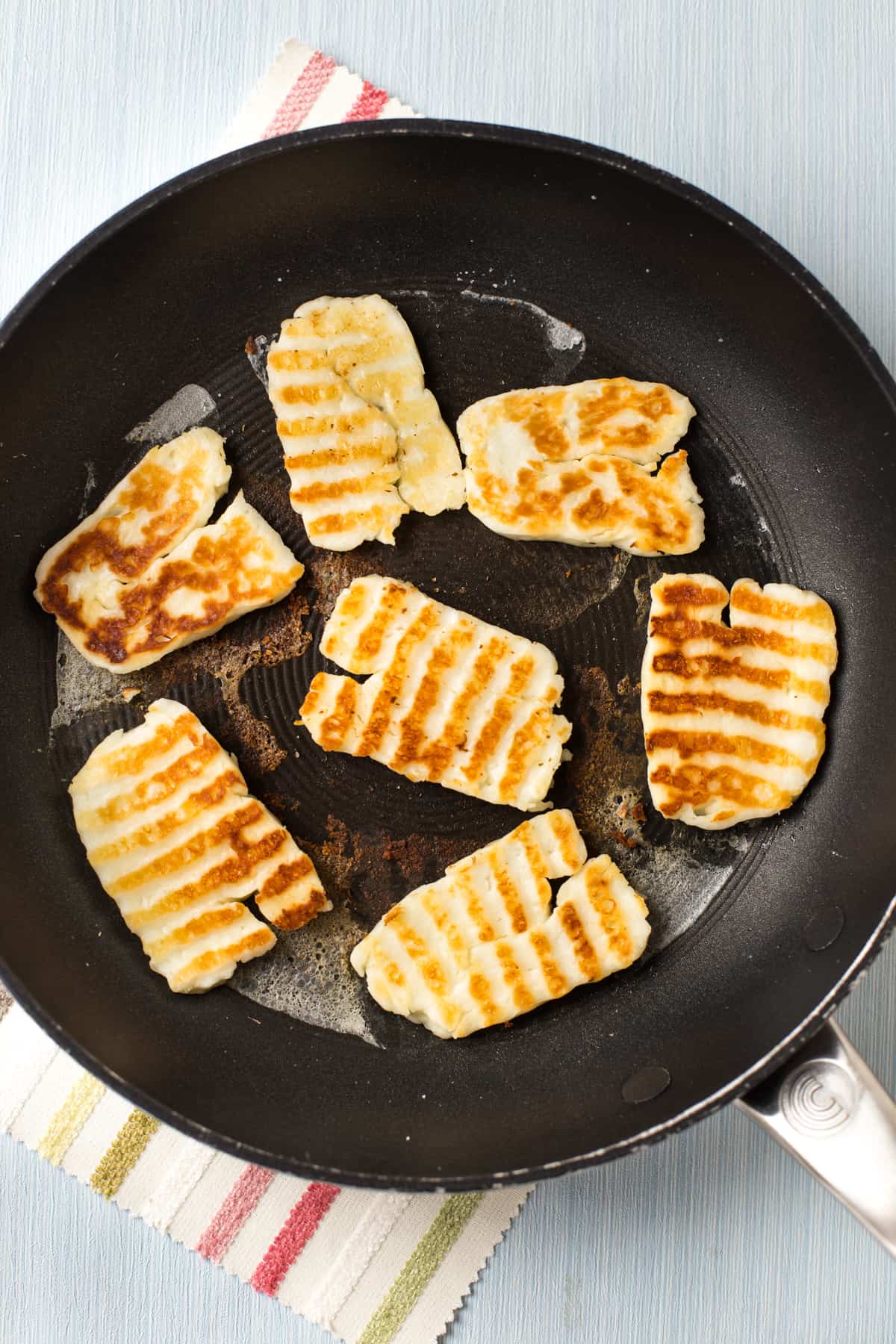
➕ Halloumi Recipes
If I’ve inspired you to give halloumi a try, I’ve posted a huge round-up of delicious vegetarian halloumi recipes – just click the image below to see them!
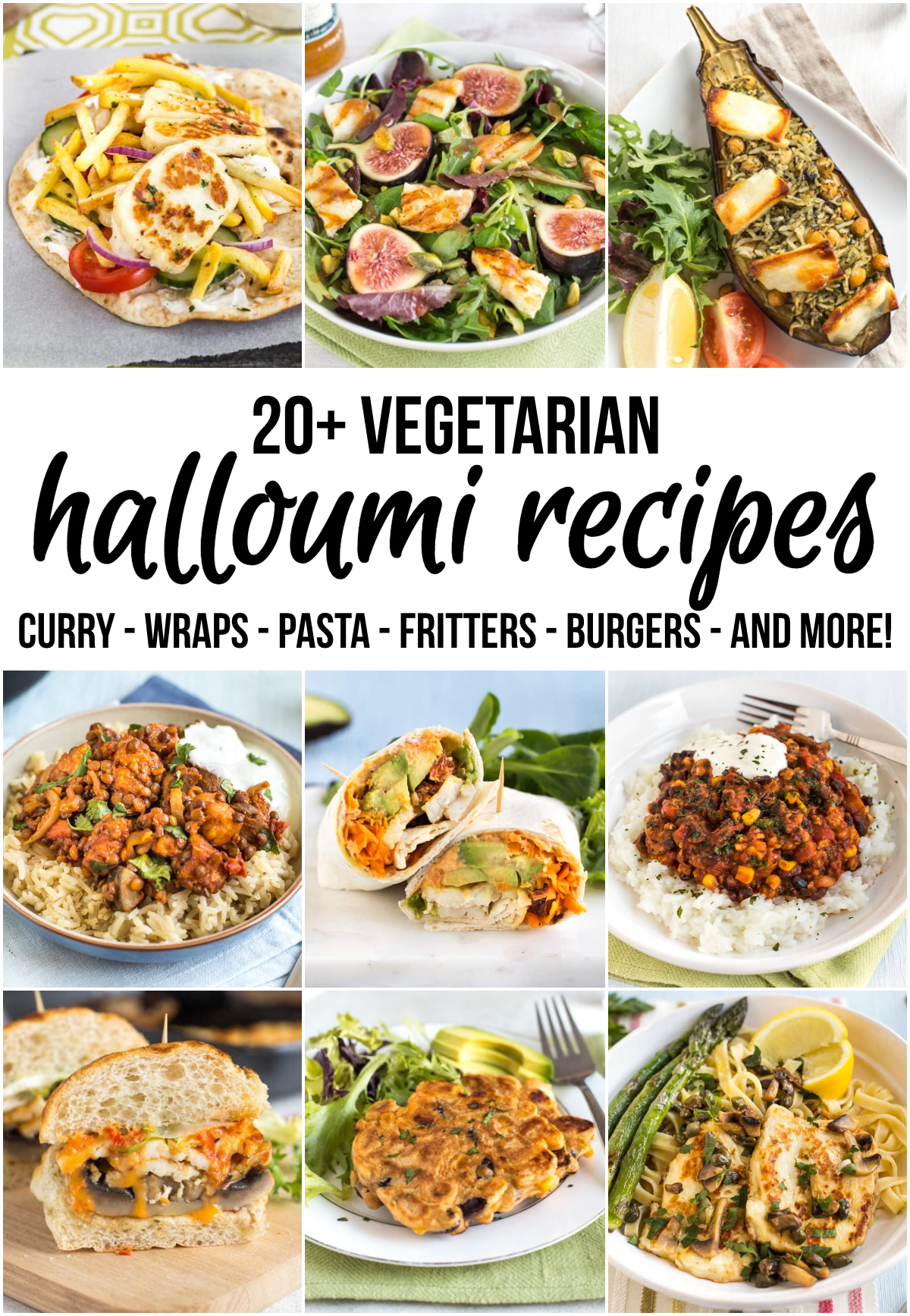
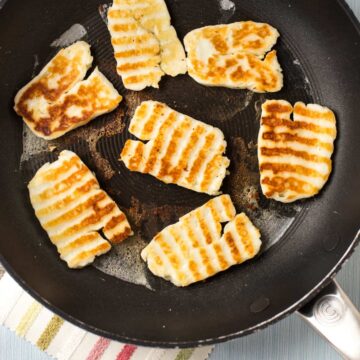
How to Cook Halloumi Perfectly
If you’ve cooked this recipe, don’t forget to leave a star rating!
Print Pin CommentIngredients
- 1 block halloumi cheese (usually around 225g / ~ 8 oz)
Instructions
- Cut the block of halloumi into slices. Don't make them too thin – around half a centimetre thick is good. You can use a crinkle cutter to cut the halloumi if you'd like the fake 'grill lines'.
- Place a non-stick frying pan over a medium heat, and add the slices of cheese in a single layer. Don’t overcrowd the pan. Allow the cheese to cook for a few minutes without moving it – it will release some liquid, which will then cook off. When the excess liquid has evaporated, the underside of the cheese will turn golden brown fairly quickly. When it’s cooked to your liking, turn each piece over, and repeat with the other side. The second side will brown more quickly, as the liquid has already been released.
- Fried halloumi is best served immediately.
Notes
Nutrition
Nutritional information is approximate, and will depend on your exact ingredients. Please calculate your own nutritional values if you require accuracy for health reasons.

Halloumi is literally one of my favourite cheeses – so much flavour – I love it with lightly stirred kale and green lentils – so good. Thanks for sharing
Laura x
That sounds like a wonderful combination :)
Yum! I love halloumi, it really is the perfect cheese!
I followed your instructions and cooked halloumi last night, and served it on a bed of slow-fried sweet potatoes, tomatoes, red onion and butternut squash (could have roasted them but couldn’t be bothered to turn the oven on!). Lush!
Oh yuuum that sounds amazing. Glad it was a success!
I will never forget the first time I had halloumi. It was amazing! It’s difficult to find in the US in some areas. There’s a Mexican cheese that’s friable, but the flavor isn’t quite the same.
I love halloumi and it is a perfect cheese for frying like this, great post!!
It seems delicious but it is unfortunately pretty difficult to find in France :(
That’s a shame! You’ll have to pick some up next time you’re travelling ;)
Bonjour Clementine, je trouve mon Halloumi dans un magasin Turc sur Paris ☺ c’est trop bon !!!!
Halloumi is a total WONDER of a food! I used to eat it by the kilo at university, I could find a way to incorporate it into every single meal in some form or another…I particularly like it as a topping to a little rocket salad with beetroot and walnuts (I know goat’s cheese would be the usual cheese in this meal, but halloumi works with everything in my opinion).
I definitely want to try the mushroom bruschetta, what an amazing idea :)
That sounds like an awesome combination! :)
My favourite cheese too! It works so well with so many flavours, but isn’t bland either. I make this recipe a lot and it’s one of my favourites, with middle eastern flavours and a peri peri sauce: http://www.bbc.co.uk/food/recipes/piripiriprawnsandhar_86697 – I just sub the prawns for halloumi. You need to try it, it’s absolutely delicious!
Sounds great!!
i have not yet tried this cheese. since you said its the king of cheese, need to get on IT.
Try it and report back! ;)
Halloumi is incredibly delicious used it often for sandwiches with some grilled vegetables and a bit balsamic vinegar on top! Usually I prepare halloumi overnight in a spicy chipotle marinade then bake it. Your method seems really easy and straightforward, thanks for sharing!
I’ve never tried baking it, that’s an interesting idea! The chipotle marinade sounds awesome too.